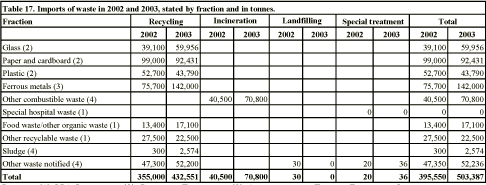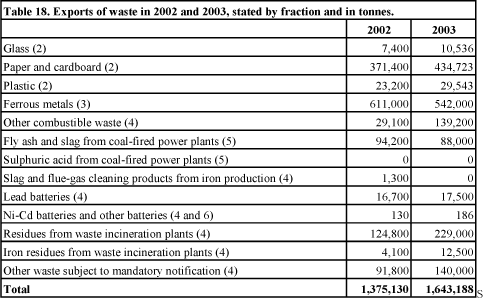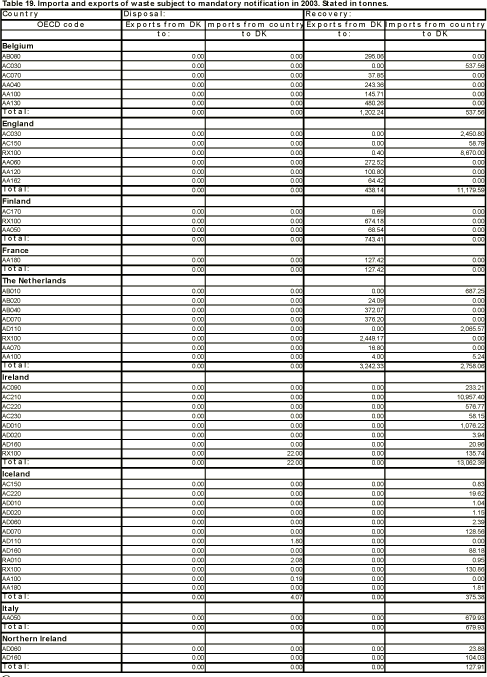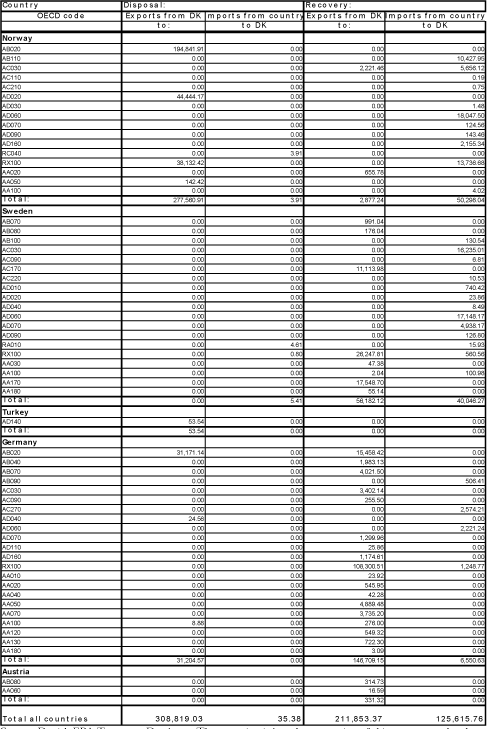|
Waste Statistics 2003 4 Imports and exports of waste4.1 Imports 4.1 ImportsTable 17 shows the amount of waste imported to Denmark in 2002 and 2003 by waste fraction and treatment option. In 2003, 503,387 tonnes of waste were imported, which is 107,837 tonnes more than in 2002. The amount of waste imported in 2003 corresponds to around 4 per cent of total waste generated in Denmark. This is one percentage point more than in 2002, where imported waste corresponded to 3 per cent of the total waste generated in Denmark. 
Source: (1) ISAG reports; (2) Statistics Denmark; (3) Association of Danish Recycling Industries and other large scrap dealers; (4) registrations under the EU regulation on shipments of waste: Council Regulation No. 259/93 on the supervision and control of shipments of waste within, into and out of the European Community. Around 70 per cent of imported waste is categorised pursuant to the EU regulation on shipments of waste [18] as so-called green waste for recovery. Green waste covers primarily glass, paper and cardboard, plastic, ferrous metals, and organic waste. Green waste is not subject to mandatory notification under the EU regulation on shipments of waste. Waste imported belonging to the category “other combustible waste” is destined for incineration with energy recovery, and comprises different types of waste oil. This is waste subject to mandatory notification and it is therefore also included in Table 19. 4.2 ExportsTable 18 shows the amount of waste exported from Denmark in 2002 and 2003. The amount of waste exported from Denmark in 2003 corresponded to around 13 per cent of the total waste generated in Denmark. In 2003, waste exports amounted to 1,642,188 tonnes, or around 268,058 tonnes more than in 2002. The increase is especially attributable to an increase in exports of other combustible waste, the major part of which is waste from the manufacturing and processing of meat, fish, and other foods of animal origin. A detailed statement of the amount of exported waste subject to mandatory notification is found in Table 19. Around 62 per cent of waste exported from Denmark in 2002 belongs to the category “green waste for recovery”. This category includes the fractions glass, paper and cardboard, plastic, and ferrous metals. 
Source: (1) ISAG reports; (2) Statistics Denmark; (3) Association of Danish Recycling Industries and other large scrap dealers; (4) registrations under the EU regulation on shipments of waste: Council Regulation No. 259/93 on the supervision and control of shipments of waste within, into and out of the European Community; (5) Elsam and Energi E2; (6) the Danish EPA registered 110 tonnes of Ni-Cd batteries collected in 2002 and 62 tonnes in 2003. 4.3 Imports and exports of waste subject to mandatory notificationTable 19 shows the countries to and from which Denmark has exports and imports of waste subject to mandatory notification. Waste subject to mandatory notification means waste that must be notified to the competent authorities of dispatch and the competent authorities of destination according to Council Regulation No. 259/93 on the supervision and control of shipments of waste within, into and out of the European Community. As can be seen from the table, in 2003 Denmark imported 35 tonnes of waste for disposal, which is about 9 tonnes less than in 2002. This waste originated from Ireland, Norway, and Sweden, and primarily consisted of other waste, peroxides, and PCB waste. In 2003, Denmark imported around 125,600 tonnes of waste for recovery. Most of this waste originated from Norway and Sweden and primarily consisted of waste oil and alkaline solutions etc. The amount of imported waste in 2003 destined for recovery rose by 37,809 tonnes compared to 2002, when around 87,806 tonnes of waste were imported. Waste subject to mandatory notification exported for disposal amounted to 308,819 tonnes in 2003, which is 158,943 tonnes more than in 2002. This waste was exported to Norway, Germany, and Turkey and primarily consisted of residues from incineration plants. In addition, Denmark exported 211,853 tonnes of waste subject to mandatory notification destined for recovery. This is around 94,118 tonnes more than in 2002. Countries of destination were primarily Sweden and Germany. The waste types concerned were mainly waste from processed cork and wood, lead batteries, and other waste. 
Cont. 
Source: Danish EPA Transport Database. The reporting is based on reporting of shipments completed under the EU regulation on shipments of waste (Council Regulation No 259/93. The competent authorities of destination must submit copies of the completed consignment note to the competent authorities involved no later than 3 days from receipt of the waste. No later than 180 days after receipt of the waste, the consignee must send proof that the waste has been recovered. OECD waste codes are described in detail in Commission Decision of 21 October 1994 (OJ 1994 L288/36). The table has been changed compared to Waste Statistics 2002. OECD waste codesAA010 Dross, scalings and other wastes from the manufacture of iron and steel. AB010 Slag, ash and residues, not elsewhere specified or included. AC010 Waste from the production/processing of petroleum coke and bitumen, excluding anode butts. AD010 Wastes from the production and preparation of pharmaceutical products. RA010 Wastes, substances and articles containing, consisting of or contaminated with polychlorinated biphenyl (PCB) and/or polychlorinated terphenyl (PCT) and/or polybrominated biphenyl (PBB),
including any other polybrominated analogues of these compounds, at a concentration level of 50 mg/kg or more. RB010 Asbestos (dusts and fibres). RC010 Wastes that contain, consist of or are contaminated with any congenor of polychlorinated dibenzo-furan RX100 Other wastes not specified with an OECD code. Footnotes [18] Council Regulation No. 259/93 on the supervision and control of shipments of waste within, into and out of the European Community
|